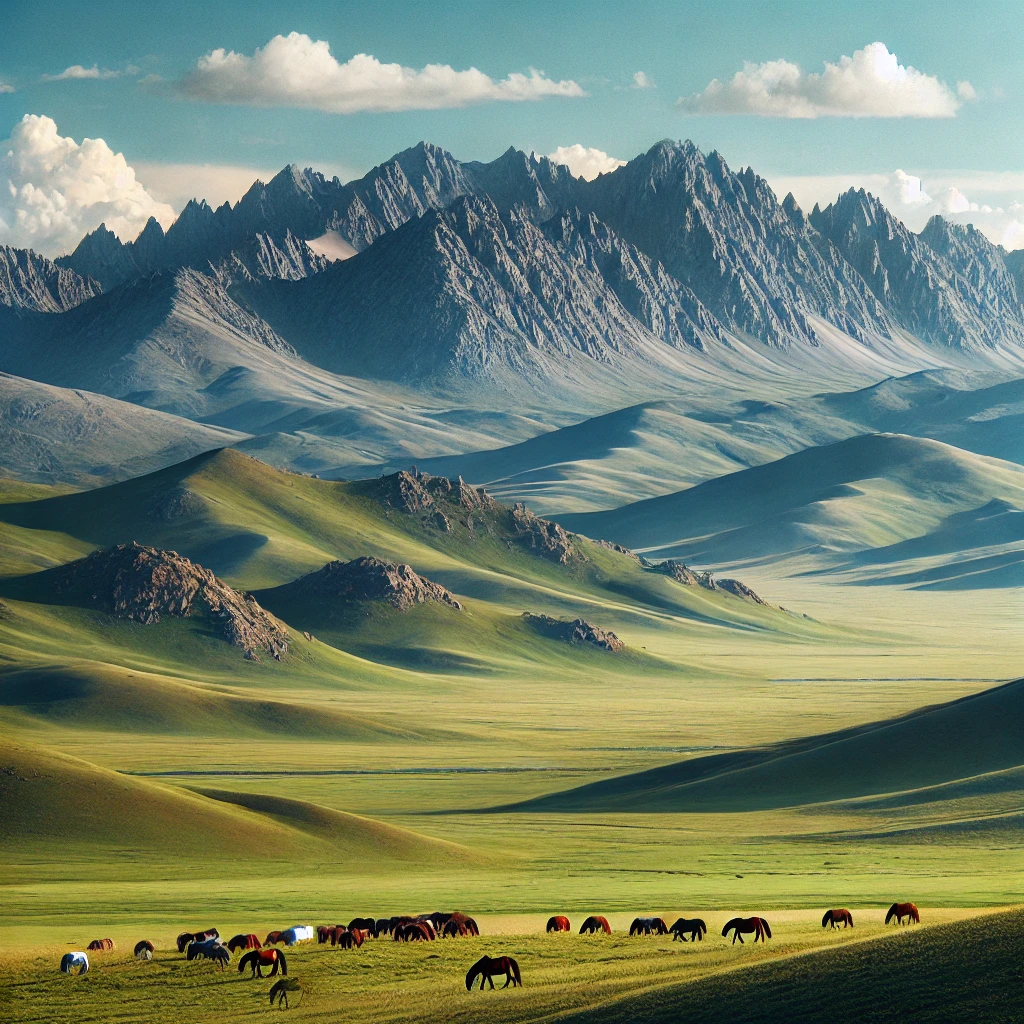Table of Contents
The Ancient Art of Tuvan Throat Singing: A Spiritual Connection to Nature
Tuvan throat singing, also called Khoomei, is a captivating vocal technique that originates from the Tuva Republic, a remote region in southern Siberia, Russia, bordering Mongolia. This ancient art form has been practiced for centuries, rooted deeply in Tuvan culture, spirituality, and their close relationship with the natural world. Throat singing was initially developed by Tuvan herders who sought to mimic the sounds of their surrounding environment—wind, water, and animals—as they traveled the vast steppe. By producing multiple tones simultaneously, singers replicate these natural harmonies, creating a mesmerizing, ethereal sound. This practice became a way to communicate with nature and express the Tuvans’ reverence for the land, linking their voices directly to the forces around them.
Tuvan throat singing, historically a male-dominated tradition believed to channel nature’s power, served as a spiritual practice where the singer’s voice connected with the earth’s energy. This unique vocal technique, which produces overtones resonating deep within the chest and throat, reflects the Tuvans’ cultural identity and spiritual strength. Over time, it has gained global recognition for its distinct sound and cultural significance.
Exploring the Styles of Tuvan Throat Singing: From Gentle Breezes to Earthy Growls
Tuvan throat singing encompasses a variety of distinct styles, each with its own sound and technique. Among the most recognized are Khorekteer, Khoomei, Sygyt, and Kargyraa, all of which involve manipulating vocal cords and resonance cavities to produce multiple notes at once. This remarkable ability allows singers to replicate the natural harmonies of their environment. Khoomei, the namesake of the broader throat singing tradition, is characterized by a soft, airy tone, reminiscent of a gentle breeze, evoking the sounds of wind and flowing water. Each style in throat singing is an auditory tribute to the Tuvans’ surroundings, with singers drawing inspiration from the vast landscapes and wildlife that have shaped their culture for centuries.
Sygyt and Kargyraa further demonstrate the versatility of Tuvan throat singing. Sygyt, with its high-pitched, whistle-like sound, mimics the calls of birds, cutting through the air with a sharp, bright clarity. It requires intense control of the tongue and throat muscles to achieve its piercing tone. On the other end of the spectrum is Kargyraa, a deep, growling style that reverberates with earthy overtones, akin to the rumbling of distant thunder or the growl of an animal. This low-frequency style is achieved by creating deep chest resonance, producing a sound that feels grounded and connected to the earth. Together, these styles showcase the range and complexity of Tuvan throat singing, each reflecting different aspects of nature’s voice.
Khorekteer: The Foundational Sound of Tuvan Throat Singing
Khorekteer is widely regarded as the foundational technique in Tuvan throat singing, setting the stage for more complex styles. In Khorekteer, the singer produces a single, low-pitched drone that resonates deeply in the chest. This drone-like sound is rich and meditative, creating a vocal base from which subtle overtones emerge. The resonance of the singer’s chest and throat combine to generate a harmonious blend of low frequencies and higher pitches, forming the distinctive layered effect that throat singing is known for. As the simplest form of Khoomei, Khorekteer serves as the starting point for mastering other, more intricate vocal styles, making it essential in the training of Tuvan throat singers.
Khorekteer’s deep, steady sound is not only musically important but also carries cultural and spiritual significance. It is often used in ceremonial and ritual contexts, where its steady drone acts as a vocal grounding force. The meditative quality of Khorekteer allows singers and listeners alike to experience a profound connection to the land, reflecting the Tuvans’ deep reverence for nature. This technique’s simplicity belies its power, as it evokes the natural rhythms and energies of the earth. Through Khorekteer, singers embody the very essence of their environment, making it an integral component of Tuvan throat singing’s spiritual and cultural traditions.
Khoomei: The Gentle Wind of Tuvan Throat Singing
Khoomei is the most widely practiced and recognized form of Tuvan throat singing, known for its soft, harmonious sound that evokes peace and tranquility. In this style, singers create an overtone melody that floats above a continuous drone, resulting in a serene and soothing effect. The sound of Khoomei is often compared to natural elements like the gentle wind, the flowing of rivers, or the rustling of leaves. Its calming presence makes it a popular style for more relaxed and intimate settings, where it captures the essence of nature’s quiet beauty. The vocal technique required for Khoomei involves delicate control of the throat and vocal cords to create this melodic layering of sound.
Positioned as the “middle ground” in Tuvan throat singing, Khoomei sits between the higher-pitched, sharp clarity of Sygyt and the deep, guttural resonance of Kargyraa. This balance of pitch and intensity gives Khoomei a versatile role in the world of throat singing. Its gentle sound is often used to connect with the natural world, and the technique has been passed down through generations as a way to honor the surrounding environment. Whether performed in cultural gatherings or meditative practices, Khoomei remains a core expression of Tuvan spirituality, reflecting the harmonious relationship between humans and nature through its flowing, wind-like melodies.

Sygyt: The Whistling Birdsong of Tuvan Throat Singing
Sygyt, translating to “whistle,” is one of the most distinctive and striking styles of Tuvan throat singing, renowned for its high-pitched, flute-like sound. Singers achieve this piercing overtone through precise tongue movements and refined vocal tension, producing a sound that often resembles birdsong or the shimmering whistle of wind sweeping through the mountains. The technique allows for a sharp, clear tone that rises above a base drone, captivating listeners with its delicate yet powerful presence. Despite its light, airy quality, Sygyt demands significant vocal skill, requiring careful control of the breath, throat muscles, and resonance to maintain its precise pitch and intensity.
In contrast to the deep, growling tones of Kargyraa, Sygyt showcases the versatility of Tuvan throat singing by focusing on the upper vocal registers. The whistle-like overtone creates a bright, ethereal soundscape, evoking the natural melodies found in the environment, from birds chirping to wind rustling through trees. Sygyt’s high-pitched resonance requires intense physical control, with singers often using tongue and lip adjustments to manipulate the sound. This contrast between Sygyt’s sharp clarity and the earthier, low tones of other styles like Kargyraa highlights the complexity and breadth of Tuvan throat singing, each style reflecting different aspects of the natural world.
Kargyraa: The Deep Growl of Tuvan Throat Singing
Kargyraa is one of the most profound and recognizable styles of Tuvan throat singing, characterized by its deep, rumbling sound, often likened to the growl of an animal or the distant roar of thunder. Singers use their vocal cords in a highly controlled manner to produce low-pitched overtones that resonate deeply in the chest, creating a sound rich in harmonic depth. The technique involves generating vibrations that travel through the body, resulting in a powerful, resonant tone that is both primal and evocative. This style’s earthy, grounded quality makes it ideal for imitating the powerful sounds of nature, such as the rumbling of thunder or the growl of a predator.
Kargyraa’s deep, guttural tone is not only musically captivating but also holds significant spiritual meaning in Tuvan culture. Its low frequency and intense resonance are associated with strength, power, and a profound connection to the natural world. The deep growl produced by Kargyraa is believed to evoke the elemental forces of the earth, such as the distant roar of waterfalls or the rolling echoes of mountains. This style requires immense breath control and vocal strength, as the singer must maintain a steady, low-pitched drone while creating complex harmonic overtones. In Tuvan tradition, Kargyraa is often used in ceremonial contexts, reflecting its association with spiritual depth and natural power.
Borbangnadyr and Ezengileer: Techniques of Mastery in Tuvan Throat Singing
Borbangnadyr and Ezengileer are advanced vocal techniques that add depth, texture, and rhythmic complexity to Tuvan throat singing. Borbangnadyr, often described as a trill-like effect, is used to mimic natural sounds such as birdsong or the babbling of brooks. Singers create this effect by rapidly moving their tongue and lips, producing a sound that flows and ripples, much like a stream running through the landscape. This technique enhances the overall performance by layering subtle, high-pitched trills over the primary drone, enriching the sonic landscape. Borbangnadyr is often employed in styles like Sygyt or Khoomei, where its delicate, fluid tones complement the airy, ethereal overtones that characterize these forms of throat singing.
Ezengileer is a throat singing technique that emulates the rhythmic sound of horseback riding through the pulsating clop of hooves, named after the Tuvan word for stirrup. It involves the singer manipulating the velum to create a dynamic rhythm, particularly enhancing styles like Kargyraa with deep tones and hoof-like pulses. Together with Borbangnadyr, Ezengileer demonstrates the versatility of Tuvan throat singing, turning the vocal performance into a rich auditory experience reflecting the natural world.
Chylandyk and Dumchuktaar: Fusion and Nasal Singing in Tuvan Throat Singing
Chylandyk is a sophisticated and intricate style within Tuvan throat singing, merging the distinct techniques of Sygyt and Kargyraa to create a complex, layered soundscape. This fusion allows the singer to produce both high-pitched and low-pitched tones simultaneously, resulting in a unique auditory experience. The sharp, whistling tones of Sygyt, often compared to birdsong, are paired with the deep, resonant rumble of Kargyraa, which is likened to the growl of thunder. This combination evokes a soundscape where the natural world’s contrasting elements—light and dark, air and earth—come together. Chylandyk has been described as producing sounds reminiscent of crickets chirping amidst a rolling storm, blending these sonic extremes into a singular, mesmerizing performance.
Dumchuktaar, by contrast, involves the technique of nasal singing, where sound is produced primarily through the nasal cavity rather than the mouth. This style often creates a softer, more delicate sound that complements the powerful tones of other Tuvan throat singing styles. Dumchuktaar, which translates to “singing through the nose,” is frequently associated with women in Tuvan culture and produces a light, humming effect. This technique adds a gentler layer to throat singing, making it an excellent counterpart to the more intense, chest-driven styles like Kargyraa. By utilizing the nasal passages, Dumchuktaar contributes to the diverse range of vocal textures in Tuvan throat singing, emphasizing the breadth of expression possible within this ancient art form.

Women in Tuvan Throat Singing: Breaking Barriers in a Male-Dominated Tradition
Traditionally, Tuvan throat singing was considered an art form reserved for men, with societal beliefs discouraging women from participating due to fears that it could cause infertility. These cultural taboos kept female singers largely in the shadows, limiting their performances to private settings or specific ceremonial contexts. However, some women continued to practice throat singing quietly, preserving the tradition within their families and communities. Historical accounts of women throat singers exist, though they often performed in secret or at home, passing down the skill through generations despite the cultural restrictions. This long-standing belief contributed to the male dominance in the art, reinforcing throat singing as a spiritual and physical endeavor meant only for men.
In recent decades, female performers have begun to challenge cultural norms in Tuvan throat singing, with Tyva Kyzy—founded in 1998 as the first all-female professional group—leading the way. Under Choduraa Tumat’s leadership, they have broken barriers and dispelled myths about women’s participation in this art form, mastering its demanding techniques and gaining international recognition. Their involvement has expanded the tradition, allowing Tuvan throat singing to evolve with new voices.
The Rise of Tyva Kyzy: A Cultural Shift in Tuvan Throat Singing
Tyva Kyzy, meaning Daughters of Tuva, is the first professional all-female ensemble of Tuvan throat singing, led by Choduraa Tumat. The group challenges traditional taboos against women in this art form, showcasing their ability to master throat singing while gaining recognition both in Tuva and internationally. By performing various styles like Sygyt, Khoomei, and Kargyraa, Tyva Kyzy symbolizes cultural pride and gender equality.
Tyva Kyzy’s rise has had a profound impact, not only in the preservation of Tuvan throat singing but in redefining what it means to participate in this art form. Their performances serve as a testament to the versatility and resilience of Tuvan culture, highlighting that tradition can evolve while still maintaining its roots. Through their music, they have inspired new generations of female throat singers, encouraging young women to pursue a practice that was once considered taboo for them. Tyva Kyzy continues to challenge stereotypes and expand the legacy of Tuvan throat singing, ensuring that this unique cultural expression thrives and evolves with the inclusion of diverse voices.
Modern Tuvan Throat Singing and Its Global Influence
In recent decades, Tuvan throat singing has gained international acclaim, expanding far beyond its origins in the remote steppes of Siberia. Musicians and artists from various genres, including world music, experimental, and even rock, have incorporated Tuvan throat singing techniques into their works, bringing this ancient vocal tradition into new musical contexts. Its distinctive sound, which mimics natural elements like wind and animal calls, has captivated global audiences. Festivals, workshops, and collaborations have played a key role in preserving and revitalizing the practice, allowing new generations of singers and listeners to experience the profound cultural heritage of Tuva. Through these efforts, throat singing has moved from a regional practice to a celebrated global art form.
Prominent Tuvan throat singers, such as Kongar-ool Ondar and the group Huun-Huur-Tu, have become cultural ambassadors, touring internationally and spreading awareness of this unique tradition. Their performances showcase the versatility of throat singing, whether in its traditional form or fused with modern musical elements. As a result, Tuvan throat singing has gained widespread recognition, not only as a cultural treasure but as a versatile musical technique with the power to transcend borders. Today, it stands as a testament to the resilience of Tuvan culture, proving that ancient practices can thrive in a modern world, continuously inspiring new audiences with its otherworldly sounds and spiritual depth.

Summary: The Rich Tradition of Tuvan Throat Singing
Tuvan throat singing is a deeply ancient and spiritually significant vocal art, originating from the Tuva Republic in southern Siberia. This unique tradition, rooted in the Tuvans’ close connection to nature, allows singers to produce multiple tones simultaneously, creating sounds that mimic natural elements such as wind, water, and animal calls. With core styles like Khorekteer, Khoomei, Sygyt, and Kargyraa, each offering distinct tones and resonances, Tuvan throat singing reflects the beauty and complexity of the natural world. Techniques like Borbangnadyr, which mimics birdsong, and Ezengileer, which evokes the rhythm of horseback riding, add further layers of intricacy to these vocal performances.
Despite long-standing taboos that once restricted women from practicing throat singing, modern performers like the all-female group Tyva Kyzy have broken through these barriers, bringing female voices into the forefront of this cultural tradition. Tyva Kyzy’s contributions have not only preserved the art form but have also expanded it, ensuring that Tuvan throat singing continues to thrive and evolve in the contemporary world. Today, this profound art is recognized globally for its spiritual depth, technical mastery, and rich cultural heritage.
How useful was this post?
Click on a star to rate it!
Average rating / 5. Vote count:
No votes so far! Be the first to rate this post.
Author
-
Meet Dr. Kendall Gregory, a highly accomplished professional with a remarkable academic background and a deep passion for empowering individuals through knowledge. Dr. Gregory’s educational journey began with a Bachelor of Science degree, followed by a Doctor of Chiropractic Medicine, focusing on diagnosing and treating musculoskeletal conditions. He further expanded his expertise with a Master's degree in Oriental Medicine, specializing in acupuncture and Chinese herbology, and a Master's degree in Health Care Administration, emphasizing his dedication to improving healthcare systems. Dr. Gregory combines his extensive knowledge and practical experience to provide comprehensive and integrative healthcare solutions. Through his writings, he aims to inspire individuals to take charge of their health and make informed decisions.
View all posts








Really awesome to see how our voices can be used as instrument like this. Learned a lot about real skill and talent today. Fantastic read!